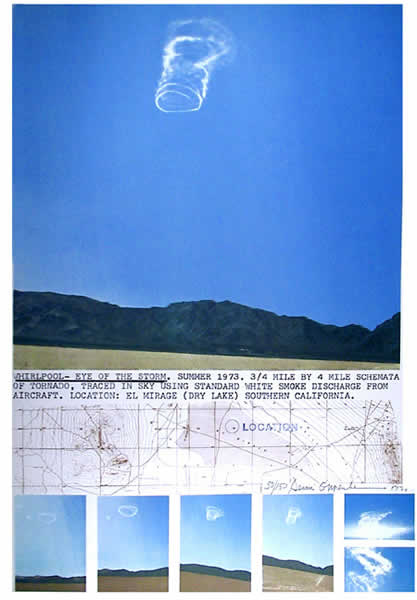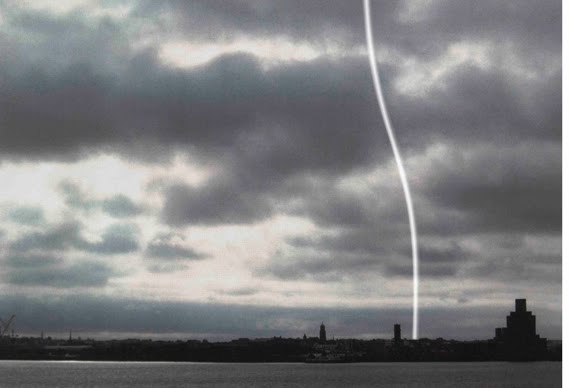 [Image: A project by Haus-Rucker-Co].
[Image: A project by Haus-Rucker-Co].
ONE
Three men with oversize briefcases show up in New York City. They drop their cases onto the sidewalk and leave them there, disguised amongst the workday crowds, several blocks away from one another, unattended. Ten minutes later, the cases pop open: a whirring sound is heard as small industrial fans begin to operate, inflating carefully packed chains of linked polyethylene structures. Buildings emerge, expanding out from each case until entire rooms and corridors block the street. No one knows how to turn the fans off. The buildings are growing, labyrinthine, turning corners now and halting traffic. A news helicopter captures the scene from above as the transparent walls of huge empty buildings made of air flash with the colored lights of police cars.
 [Image: An “inflatable nested toroid structure” patented by NASA (PDF)].
[Image: An “inflatable nested toroid structure” patented by NASA (PDF)].
TWO
A man toils for thirteen years, sending ever-more complex test diagrams off to polyethylene factories in Florida. He wants to know how much it would cost for them to manufacture these parts he’s been designing, and designing well: temporary inflatable rooms that link off from other rooms, multi-scalar gaskets able to withstand knife attacks, even strange, one-time entry points that can be resealed from within. A retired cargo pilot, he dreams of giving structure to air. He writes, Man can live on air alone!, and sketches obscene bulbous shapes on paper napkins to the discomfort of passing strangers.
 [Image: Inflatable toroid test; via NASA/Wikipedia].
[Image: Inflatable toroid test; via NASA/Wikipedia].
THREE
A building made of polyethylene and sealed air takes shape on a beach near Cape Canaveral. Tourists flock to it, taking selfies and filming short videos with their kids. But the midday sun is relentless; the structure is heating and the winds are picking up. Within two hours, the complex inflated shape begins to tremble and beat against the sand, until, accompanied by an audible gasp from the assembled crowd, it is sucked out to sea. It tumbles and rolls and rises through the sky, a spinning point reflecting glints of subtropical sunlight as it disappears over the Atlantic horizon. No one can say who it was, but all witnesses insist there was a man inside. Sure enough, smartphone video of the structure being lifted over the waves reveals a man bracing himself against the interior walls, bearing an expression somewhere between mania and glee. Two weeks later, French police find him, disoriented and unshaven, lacking his passport, at a seaside bar in Arcachon. “I have a very strange story to tell you,” he slurs, before falling off his seat.
 [Image: An airplane hangar in Utah, via the U.S.
[Image: An airplane hangar in Utah, via the U.S.  [Image: Interior view of same hangar, via U.S.
[Image: Interior view of same hangar, via U.S.  [Image: Utah airplane hangar, via U.S.
[Image: Utah airplane hangar, via U.S.  [Image: Haus-Rucker-Co, Grüne Lunge (Green Lung), Kunsthalle Hamburg (1973); photo by Haus-Rucker Co, courtesy of the Archive Zamp Kelp; via
[Image: Haus-Rucker-Co, Grüne Lunge (Green Lung), Kunsthalle Hamburg (1973); photo by Haus-Rucker Co, courtesy of the Archive Zamp Kelp; via  [Image: Haus-Rucker-Co, Oase Nr. 7 (Oasis No. 7), installation at Documenta 5, Kassel (1972); via
[Image: Haus-Rucker-Co, Oase Nr. 7 (Oasis No. 7), installation at Documenta 5, Kassel (1972); via 
 [Image: “
[Image: “ [Image: “Column” by Anthony McCall, courtesy of
[Image: “Column” by Anthony McCall, courtesy of  The city of Venice has begun to rebrand its tap water, calling it
The city of Venice has begun to rebrand its tap water, calling it  [Image: Marcel Duchamp,
[Image: Marcel Duchamp,